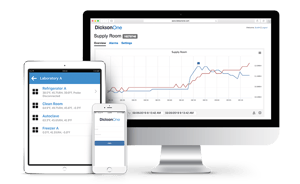The rapid pace of technological change in recent years, particularly when it comes to the Internet of Things (IoT), has reshaped many industries — including environmental monitoring. Cloud-based, remote monitoring via internet-enabled data loggers and a central interface to track them all has made tremendous progress and offers numerous organizational benefits.
We frequently receive questions from customers about whether or not remote monitoring makes sense for them. This Q&A reflects some of the most frequently asked questions, and should help you determine if remote monitoring will help you meet your organizational needs.
1) What are some advantages of remote monitoring?

There are several advantages a remote monitoring system presents versus systems that lack such capabilities. Four key areas where your organization stands to benefit are asset protection, organizational safety, resource management, and cost reduction.
Asset protection
The ability of a remote monitoring system to monitor sensitive assets and products at multiple locations via a single, centralized interface represents the most robust, continuous monitoring system available. That means you are giving your organization the best possible chance to take corrective action quickly should a potential issue arise.
Organizational safety
The aforementioned monitoring and alarm capabilities of a remote system also have tangible safety benefits. Organizations know they will be immediately notified of potentially hazardous conditions, and that the remote nature of their system means the ability to maintain continuous monitoring without employees being placed in potentially hazardous situations. The recent COVID-19 pandemic presented a direct reminder of the importance of being able to continue monitoring uninterrupted without support from on-site personnel.
Resource management
Personnel within your organization who may have been tasked with manually checking data loggers can divert that time and effort to other areas, for example patient care in a hospital environment where nurses sometimes conduct data logger checks as part of their routine.
Cost reduction
Fewer man hours devoted to monitoring has the potential to reduce organizational costs over the long term. Also, it goes without saying that the aforementioned asset protection advantages have a financial component as well, as a significant asset loss represents a substantial financial setback for any organization.
2) How do I know if my organization really needs a remote monitoring system?
The above benefits could potentially apply to organizations of any size. That said, there are several factors that make remote monitoring especially valuable for certain organizations:
Organizations with many monitoring points and/or locations
Some organizations need to monitor on an absolutely massive scale, potentially tracking thousands of different monitoring points across multiple facilities and time zones. The more significant the scope of your monitoring needs, the more the advantages that remote monitoring present become magnified.
These monitoring points take many different forms. For example, a hospital might have a single location with a huge number of different monitoring points. A university may have a reasonably contained geographic footprint, but with a variety of different facilities and monitoring needs spread throughout the campus. A large multinational corporation, meanwhile, will have a geographically diverse set of facilities to monitor with varying degrees of complexity at each location. In each of these cases, a remote monitoring system that can maintain the entire operation from any location is tremendously beneficial in terms of both safety and efficiency.
Organizations requiring multiple types of monitoring
Similarly, an organization that is simultaneously involved in multiple types of environmental monitoring may have particular interest in a remote monitoring system. Take the hospital again, for example, which has a variety of monitoring needs — from freezers to incubators to operating rooms — necessitating the tracking of temperature, relative humidity, differential pressure and other data. Having all these disparate monitoring needs centralized (especially in the case of hospital systems with multiple buildings and locations) is highly valuable.
Essentially, the more complex your monitoring needs, the more likely you are to need the capabilities of a remote monitoring system.
Organizations with highly sensitive products
Sensitive conditions are the reason environmental monitoring is conducted in the first place, but the extreme sensitivity of certain products can heighten interest in the robust alarm capabilities that a remote system can provide. Vaccines are one example of a highly sensitive and valuable asset that many organizations choose to protect with remote monitoring.
Organizations with limited availability of personnel
As discussed previously, remote monitoring allows for complete visibility into your organization’s monitoring with minimal input from actual on-the-ground personnel. If your organization is limited for any reason in terms of the time and personnel it can devote to its monitoring practices, a remote monitoring system may prove to be the most sensible choice.
3) How complicated is it to implement a remote monitoring system?
It really depends on the product in question. A well-designed remote monitoring system such as DicksonOne typically has a simple and straightforward installation process: once the hardware is installed (there’s no software to install) and your account is configured, you are essentially ready to go. However, your mileage on ease of use may vary depending on the provider you select.
The company providing your remote monitoring system should be able to provide installation support, and should work with your IT department to make sure everything is installed to your specifications.
Physically speaking, there are no special tools required, other than mounting hardware for the interface if desired.
4) Is remote monitoring easy to customize?
A good remote monitoring system will be highly customizable based on your needs and preferences. This should include recurring reports that can be adjusted to meet your specifications, an easy process for adding or removing users to reflect the pool of people you want involved in your monitoring efforts, simple customization for alarms and notifications, and an intuitive process for incorporating a new data logger or other device into your account.
5) Can I monitor multiple facilities at once?
Yes, a good remote monitoring system has the capacity to support systems of any size and geographic configuration. As previously mentioned, organizations dealing with multiple facilities typically have the greatest need for remote monitoring, which has the capability to track data from around the globe in a single cloud-based interface.
6) How does the system notify me of a problem?
Depending on your preferences, your remote monitoring system should support email, text, and phone alerts for as many users in your organization as you would want receiving such alerts. Any issue warranting attention will trigger an alert immediately.
7) If I have an audit coming up what should I do with my remote monitoring system?

If you have a robust remote monitoring system up and running, you are likely already in good shape for your audit, but there are still a couple of steps you may want to consider.
The first is ensuring that, if applicable, the validation for all relevant facilities and systems is up to date.
Second, you may want to take a closer look at the reporting requirements of the audit and double check that your reporting setup is optimized to easily provide all necessary information to demonstrate compliance and pass the audit.
8) What makes DicksonOne different from other remote monitoring systems?
 DicksonOne has several strengths that differentiate it as a remote monitoring system. Our decades of environmental monitoring experience have been leveraged to create a user-friendly interface and an easy-to-understand, intuitive system overall. We’ve leaned on our own monitoring expertise to make sure you do not need to be a monitoring expert to make this system work for you and seamlessly cover the needs of even the most intricate and expansive monitoring operations.
DicksonOne has several strengths that differentiate it as a remote monitoring system. Our decades of environmental monitoring experience have been leveraged to create a user-friendly interface and an easy-to-understand, intuitive system overall. We’ve leaned on our own monitoring expertise to make sure you do not need to be a monitoring expert to make this system work for you and seamlessly cover the needs of even the most intricate and expansive monitoring operations.
When it comes to enforcing standard operating procedures (SOPs), DicksonOne has several features that will prove advantageous, especially when managing a large number of devices. Default device settings create a baseline to which all data loggers will automatically conform (these can be overridden in cases where they do not apply), which significantly reduces the time and effort needed to incorporate new devices into the system.
The ability to easily and systematically template alarms is another major benefit when it comes to enforcing SOPs. Organizations that previously had dozens of different alarm templates have been able to reduce that number to a handful using DicksonOne. Also, the ability to distinguish between alarm conditions and notifications adds another layer of customization to ensure your team receives all relevant updates in the most efficient possible manner.
Should the need to make changes across all or some of your devices arise, our bulk editing tool makes it easy to select the relevant devices and programmatically implement the desired adjustments.
Also, some systems limit the number of users or licenses, or charge for additional users. With DicksonOne you automatically enjoy unlimited users, meaning anyone within your organization you would like to have a view into your monitoring can be added without having to weigh the cost or ration the distribution or licenses.
9) What do I need to do to install DicksonOne?
The DicksonOne system is browser-based, so you will be able to use DicksonOne for your environmental monitoring on any modern browser via any device.
For the on-site installation, we work proactively with your IT team early in the process to identify any potential issues surrounding network configuration or security so that when it comes time to implement the system, everything runs smoothly.
10) Will adding DicksonOne require me to get new data loggers?
Possibly. If you have older data loggers that are not compatible with DicksonOne you may need to purchase new ones that will support cloud-based monitoring.
That said, you may be able to use our legacy uploader so that your previous data from DicksonWare is incorporated and accessible through the DicksonOne interface. More on that here.
Have more questions about remote monitoring? Feel free to add them in the comments section below, or contact Dickson today.
About the author: Before coming to Dickson, Director of Services Antoine Nguyen spent more than 18 years in quality and validation roles in the pharmaceutical and medical device industries.


